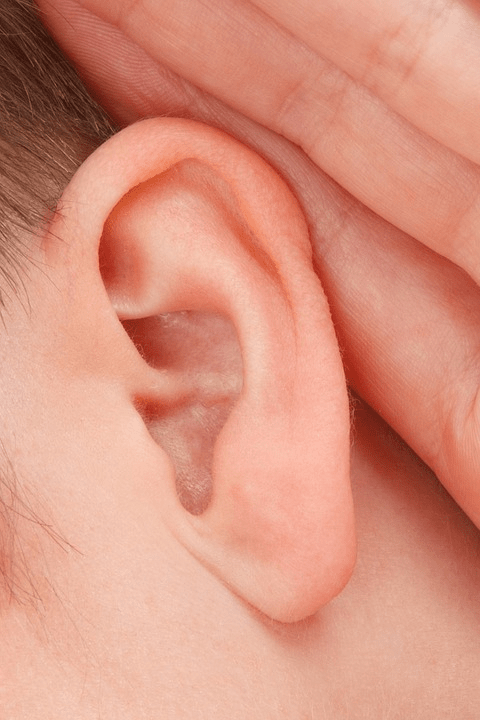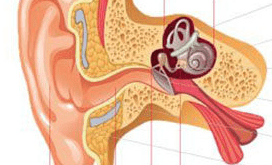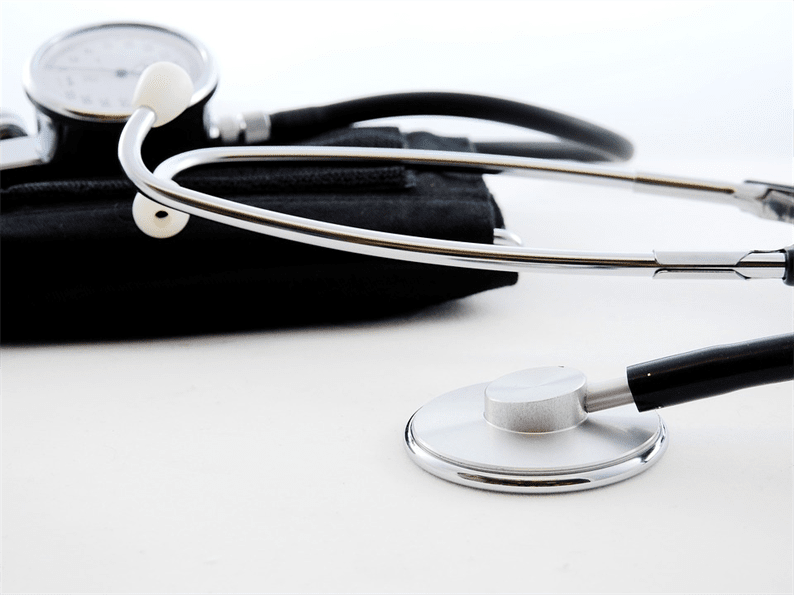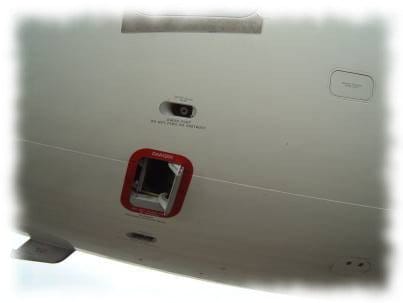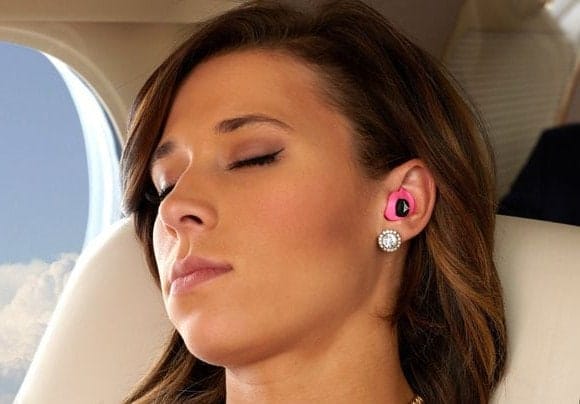After the plane, my ears were blocked. Why does it stick its ears on the plane? Reasons for what to do, photos and videos
Cause of ear popping in flight
Earache is caused by changes in the air pressure in the cockpit during takeoff and landing. As the altitude increases, the air pressure in the atmosphere decreases. But in the cabin of the liner, it is artificially supported and at cruising altitude is about three quarters of the pressure on the surface of the earth. This compares to that on a mountain 2500 meters above sea level.
Thus, when the ambient pressure in the middle ear drops, it remains unchanged, because there is an obstacle in the form of the tympanic membrane, which is airtight for the external auditory canal. Due to the resulting excess pressure in the middle ear, the eardrum bulges outward and can no longer vibrate freely. All this is accompanied by discomfort and hearing loss. Sometimes a headache even begins.
The reverse process, accompanied, as a rule, by stronger sensations of pain and congestion occurs during landing. The eardrum is pulled inward due to insufficient pressure in the middle ear.
Interesting! The severity of pain during landing is influenced by the location of the airport. For example, when approaching the Mexico City airport, the pressure difference will be barely noticeable, since it is located at an altitude of 2200 m above sea level.
If the passenger has chronic otolaryngological problems, the likelihood of experiencing painful sensations is much higher, and the severity of symptoms will be more pronounced. Diseases that may cause discomfort and pain in the ears during the flight:
- Runny nose. With colds, accompanied by swelling of the nasal mucosa, a decrease in the diameter of the auditory tube may occur, due to which the ventilation of the ear cavity is impaired;
- Otitis. With the transferred otitis media, adhesions may remain on the tympanic membrane, which impede its free movement and return to its original position after bending;
- Benign and malignant neoplasms lead to poor penetration of sound waves and exacerbate the feeling of ear congestion;
- Hearing loss. Pathological hearing impairment caused by cerebrovascular disease or head injuries that affect the proper functioning of the auditory nerve;
- Inflammatory diseases of the auditory canal: eustachitis, myringitis, etc.
Important! For colds with severe runny nose and ear inflammations, it is better to refrain from air travel or take measures to prevent the development of an uncomfortable condition.
Water accumulation in the ears
If your ears hurt when the plane lands, and none of the above problems are present, then the problem is in the water accumulated in the ear conch. One of the common reasons for ear blocking in tourists returning from a seaside holiday is the accumulation of fluid in the ear canals.
Divers who ask why their ears are blocked on an airplane and how to deal with it should remember that when diving to a depth of water droplets fall into the external auditory region and cause swelling of the sulfuric secretion. Enlarged sulfur deposits put pressure on the eardrum and cause pain.
It is very easy to avoid unpleasant symptoms. This requires:
- Pick up a cleaning stick.
- Clean the ear canals as carefully as possible, absorbing the remaining liquid and removing excess sulfur;
- Take a few sips and open your mouth wide.
- Yawn.
For a guaranteed absence of problems, it is enough just not to dive deeply a day before the flight.
Sulfur plug
Ear pain on an airplane can be caused by wax plugs. Symptoms of the presence of an ear plug in the ear canal are:
- hearing loss;
- noise in the organ of hearing;
- a sense of echo;
- dizziness or imbalance;
- neuralgia;
- emotional and mental disorders.
All of the above symptoms are seriously aggravated during the flight.
One of the most effective methods for removing sulfur plug at home is using olive oil or hydrogen peroxide. Removal of the accumulated sulfuric secretion is carried out in several stages:
- Purchase olive oil or 3% hydrogen peroxide solution.
- Positioning the patient in a position with the damaged organ up.
- Placement of the towel under the head.
- Pipette liquid collection.
- Instillation of the ear canal with three drops of solution.
- Extraction of oil or peroxide 5 minutes after instillation.
With the successful extraction of the sulfur secretion on a towel located under the patient’s head, earwax should flow out along with oil or hydrogen peroxide. After the plug is removed, it is necessary to clean the ear canal with a cotton swab or piece of tissue.
In order to avoid stuffing your ears after the plane due to the presence of sulfur plug, you should regularly clean your ear canals with cotton swabs. If the plug is already there, you need to contact a specialist and remove it.
Provoking diseases
Among the diseases that can provoke a problem are:
- otitis;
- sinusitis;
- sinusitis.
It is worth noting that in the presence of provoking diseases, the likelihood of encountering inconveniences increases significantly. When a person has a runny nose, their ears are blocked even outside the plane. In order not to worsen the situation, it is required to thoroughly clean the sinuses before the flight.
In case of acute sinusitis or sinusitis, it is recommended to postpone the flight and treat the disease.
Plugging in the ears under pressure
When taking off or landing an airplane (climbing mountains, driving fast), most people experience ear popping.
The phenomenon is associated with the fact that the pressure on the other side of the side drops rapidly, and the body does not have time to equalize this value in the tympanic cavity in a short period of time. Sometimes pain occurs, which disappears when the level of external and internal pressure stabilizes.
You can help the body cope with discomfort faster by following these recommendations:
- Drink liquid in small sips. Passengers who regularly use airline services find the method to be the most effective. Making a swallowing movement, the pressure on both sides of the eardrum is equalized. A small child should be given a water bottle or pacifier.
- Use lollipop or chewing gum. Increased production of saliva will provoke frequent swallowing movements, which have a positive effect on stabilizing the condition.
- Instill drops with a vasoconstrictor effect into the nasal passages. The method is used as a last resort, for example, if there are signs of a cold that make it difficult for normal nasal breathing. It is necessary to use the drops before boarding the plane.
- Hold your breath for 5-10 seconds. Inhale air only through the nose, and let it out through the mouth.
- Yawn several times. They perform the action precisely during takeoff and landing, then it will be possible to avoid discomfort from the congestion of the ear canal.
- Use special earplugs. The design of the products is specially designed to smooth out sudden pressure drops during flight.
A sharp drop in atmospheric pressure almost always causes congestion in the ear canals.
How to avoid aerotitis
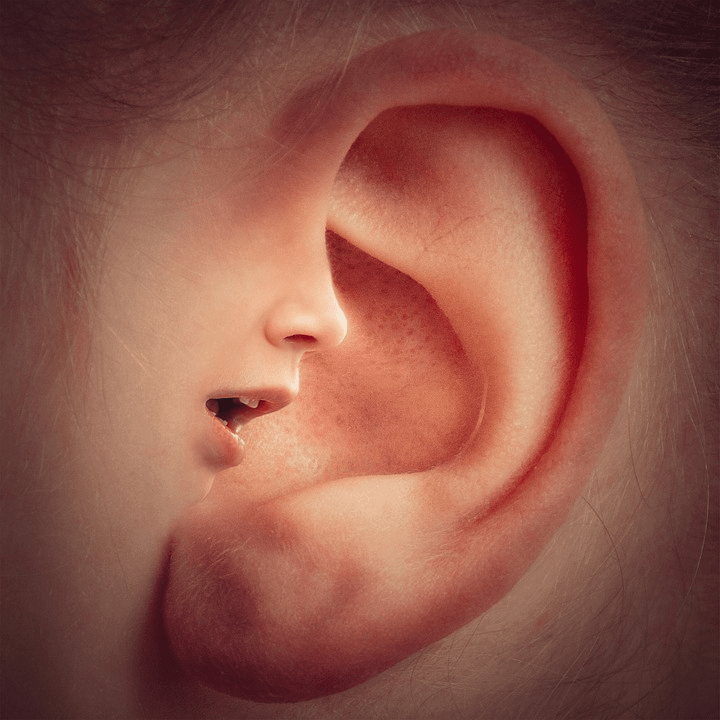 Activities that help reduce unpleasant manifestations in the ears can be carried out in advance, before the flight, and directly during the trip:
Activities that help reduce unpleasant manifestations in the ears can be carried out in advance, before the flight, and directly during the trip:
- If you have ear problems or a cold, you need to bring along vasoconstrictor drops or nasal spray. Half an hour before takeoff and landing, it is necessary to treat the mucous membrane to reduce swelling even before the pressure changes. For allergies, antihistamines should be taken;
- Buy special earplugs or earplugs from the pharmacy. The ones sold at the airport are not as effective. They slow down the pressure changes that occur in the ear during the flight;
- You should not take a shower or a bath, visit the pool just before the flight, water droplets can remain in the organ of hearing and provoke congestion;
- During sleep, the equalization of pressure is difficult, so you must not sleep yourself and wake up your fellow travelers during the climb with the liner and before the descent.
Important! Children are especially sensitive to pressure drops, since their Eustachian tube is not yet fully formed.
If, despite all the preparations, unpleasant symptoms occur, there are proven ways to return to a comfortable state.
- Chewing gum is a good method. Repeated loading of the masticatory muscles can open the Eustachian tube, which connects the ear to the posterior pharynx;
- A similar effect is achieved by drinking water in small sips or yawning. Forced to yawn may seem difficult at first, but after preliminary training it is quite possible;
- Small children should be given a bottle or pacifier to drink. Sucking lollipops with swallowing saliva will help both the child and the adult;
- Another way is to simply open your mouth. It is more effective to pinch your nose and try to swallow. A similar method is often recommended, but instead of swallowing, a sharp exhalation with the mouth closed (the Valsalva maneuver). However, it is more risky, as there is a possibility of injury to the inner ear. It is especially dangerous to use the maneuver in the presence of colds due to the possible transfer of infection;
- Pressing on the auricles and massaging them with twisting movements, which helps to improve blood flow.
Important! You cannot tolerate pain without doing anything. In some cases, complications may develop.
Environmental changes during flight
Congestion in the ears during takeoff occurs due to the upcoming pressure difference between the human body and the environment in which it has to be present. Normally, these indicators coincide, therefore, no unpleasant sensations arise in everyday life, exceptions are rarely observed. It is with pressure drops that this and when there is a difference between internal and external indicators, this symptom is recorded most often.
During takeoff, the plane accelerates and quickly gains altitude, falling into a space where the pressure is significantly lower. After all, the higher you manage to rise from the surface of the planet, the less pressure is. It is not dangerous for the human body, which can adapt to new circumstances, but it does not happen instantly.
How is the pressure equalization in the body?
In order for a person’s blood pressure to be normal, the aircraft has many systems that maintain normal atmospheric pressure. Air conditioning operates to maintain the required oxygen level inside the passenger compartment. The main problem is that at an altitude of 10 km, the oxygen content in the air is much lower.
If a person suffers from pain and clogs his ears when landing an airplane, then he needs to use chewing gum or candy. Swallowing and chewing normalizes blood pressure. That is why free caramels are often handed out when flying.
Pawns ears during pregnancy
What surprises the body will not present during the period of bearing a baby! Expectant mothers often complain of discomfort caused by congestion in the ears. You should not be afraid of such a phenomenon, because it is considered absolutely normal for any period of pregnancy and most often accompanies a woman until the very birth.
It is noticed that it is mainly the right ear, but sometimes both at the same time. Experts associate the problem with constant pressure surges in pregnant women. Particular attention should be paid to this in case of iron deficiency anemia and low hemoglobin levels in the blood.
If ear congestion is accompanied by other symptoms (acute pain, fever), you should consult your doctor.
During pregnancy, special monitoring of the state of health is needed, because the normal development of the fetus depends on it.
Painful sensations arising along with muffled sounds indicate the development of the inflammatory process. Average and acute otitis media is accompanied by an increase in temperature and the release of purulent fluid from the affected organ. Hormonal changes can give rise to the development of Meniere’s syndrome. In addition to congestion, there is noise, dizziness, and sometimes vomiting.
Often, the cause of the congestion of the auditory tubes in women in the position is overweight, sulfuric plugs, “runny nose of pregnant women” (occurs in the first trimester). An unpleasant symptom must be reported to the attending gynecologist and, upon appointment, they visit an otolaryngologist.
During pregnancy, ear congestion is not a threat only if there is no serious pathology behind the cause of the symptom.
Risk factors and complications of ear pain
Knowing why your ears hurt when you land an airplane is essential. Although such cases are rare, passengers experience barotrauma – tissue integrity disorders caused by pressure drops. Deep-sea diving enthusiasts and people who were near the epicenter of the explosion face similar consequences.
The danger is small, but certain factors increase the likelihood that pressure fluctuations during the landing and takeoff of the aircraft will harm you. These include the following:
- the small size of the Eustachian tube (for this reason, the child will suffer more from ear pain than an adult);
- colds and runny nose;
- sinusitis;
- allergic rhinitis;
- otitis media and middle ear infections.
The problem is exacerbated if you sleep during takeoff and landing: you cannot take action to normalize the pressure. As a result, tissues are damaged, and on the next flight, congestion or slight discomfort cannot be avoided. In some cases, middle ear injuries lead to the development of chronic diseases: tinnitus (constant noise and ringing) and hearing loss.
Why does the airplane pressure change during takeoff and landing?
Pressure regulating valve
It is a mistake to think that the plane is completely sealed. The fuselages have openings that allow air exchange with the environment, which ensures the regulation of the pressure inside the body. If this were not the case, the hull could have been damaged due to strong drops during takeoff and landing. A special automated system controls air exchange, adjusting the indicators in a balance that allows people to feel comfortable and eliminates the risk of damage to the case. It is thanks to her work that the pressure indicators change – without this it was impossible to achieve flight safety.
The pressure inside the aircraft begins to change already during its acceleration on the ground, and then, during takeoff, it is also subject to fluctuations. However, everything happens within the specified safe parameters. The system is equipped with emergency air release mechanisms when the pressure is exceeded, and it can also be adjusted manually, which eliminates risks. And therefore, the maximum that an unpleasant thing can happen due to pressure drops is to block the ears for a while.
Methods for getting rid of congestion
There are a number of methods for avoiding ear congestion after an airplane and during a flight. To prevent the ears from getting blocked on the plane for a child and an adult, it is enough to use one of the following methods:
- To eliminate problems with air travel, you can use the simplest procedure: open your mouth and do not close it for one minute. To improve efficiency, it makes sense to swallow several times.
- You can free your ears from congestion after a flight using the Toynbee maneuver. To equalize the pressure in the ears, simply close the respiratory system and swallow saliva. This procedure uses the muscles that open the Eustachian tubes. If the effect is insufficient, the maneuver should be carried out several times.
- Use steaming of the nasal canal. For the procedure, you must ask the stewardess for a tea bag and two cups. Pour hot water into one cup and add a bag. After that, pour 90% of the tea into an empty cup and bring the tea bag with the remaining liquid to your nose. With the gradual inhalation of steam from the bag, the pain in the hearing organ should decrease.
- The best method for treating ear congestion in young children is to actively yawn. Several powerful yawns allow you to completely pierce the vacuum lock and unblock the auditory organ.
- Another easy way to unblock the ears in children is the Valsalva maneuver. To perform the procedure, it is enough to hold your nose with your hand and exhale into it. As a rule, when the ears are unblocked in this way, the person feels a click.
- If the parents took lollipops with them, then they should be given to their son or daughter. The active resorption of the candy provokes profuse salivation and makes the child constantly swallow. Some airlines give tourists special candies designed to unblock the blocked ears.
- Twisting and massaging the auricles is also a good way to get rid of ear congestion.
- If none of the methods helped, then you can try to put pressure on the cartilaginous part of the organ of hearing, located approximately in the middle of the shell height.
- Try drinking plain water or sweet non-carbonated liquid in small sips through a straw.
Prevention and tips:
- Before departure, it makes sense to purchase special earplugs with a pressure valve. Such a device is capable of unblocking congested ears. If earplugs are not available, you can use in-ear vacuum headphones.
- If there is a runny nose, then before departure it is imperative to drip the nose with vasoconstrictor drugs, for example, Tizin or Xymelin. Such prevention will help relieve swelling and increase the lumen of the tube.
- For travelers with frequent allergies, take an antihistamine pill.
- 45 minutes before departure, you can try to open the auditory tube with a nasal spray. Such prophylaxis will help prevent ear blockages during takeoff and landing.
- If you have a runny nose just before the flight, it makes sense to steam it. To do this, pour hot water into a bowl, place your head over it and cover with a towel. The nasal passage is unblocked by inhaling hot steam. The procedure must be performed until the ear canals begin to open.
- The folk method called Cheburashka also has many positive reviews. The essence of the procedure consists in soaking napkins in hot water, placing them in plastic cups and applying containers to the auricles.
To successfully eliminate ear congestion, you should not oversleep the takeoff and landing process. If you try to relieve the congestion of the ears after a certain period of time after the problem occurs, then it will be much more difficult to do this.
Note! Under no circumstances should you try to relieve congestion with ear sticks or other hard objects. Such actions can damage the eardrum and provoke serious consequences.
Valsalva method
Before using this method, you need to blow your nose properly, which will guarantee the non-penetration of pathogenic microbes into the auricle. The method allows you to quickly get rid of the clicking in the ear, which also occurs in flight. The Valsalva method involves the following actions:
- Take a deep breath.
- Press your nostrils with your fingers.
- Exhale.
The exhalation should not be very sharp, as the nasal labyrinth can be damaged, it is possible that an infection gets into the ear, and the eardrum can be severely damaged
Toynbee’s method
The previous method is based on blowing out the ear using a set of air and a sharp descent of it. Toynbee suggested another option for cleaning if the ear is blocked after the plane or during takeoff:
- Press the nostrils down with two fingers.
- Take water in your mouth.
- Swallow water.
The congestion will pass, as the external and internal pressure will be equalized. And it is worth remembering that this procedure must be repeated until a click occurs in the ear.
Steaming when the ear is blocked
The good old way our parents taught us.
Boil a scoop of water and transfer to a large bowl. Lean over the bowl and cover your head with a towel so that your head and bowl are completely covered. Breathe in the steam to help clear your nose and ear. If you want, you can also add a couple of drops of tea tree or lavender (or chamomile) oil to the water to reduce pain and inflammation. Breathe in until you feel your ear canals begin to open.
Alternatively, you can also shower for 10 minutes.
If you have a blocked ear while flying and need quick pain relief, ask the flight attendant for a tea bag and two cups, one empty and one filled with hot water. Stir the tea bag into a cup of hot water, then pour the tea into an empty cup, leaving the tea bag and some water in the first cup. Bring the first cup to your ear; the tea bag will trap the heat from the water, and the steam from the tea bag will help relieve ear pain.
Olive oil or hydrogen peroxide
Ears can hurt after the plane and during the flight in cases where there is a sulfur plug in the ear canal. Therefore, before the flight, it is necessary to carry out medical measures to cleanse the ear from it. Otherwise, when you climb, the pain becomes acute.
At home, you can use a mixture of hydrogen peroxide and olive oil to soften the sulfur. Then the following actions are performed:
- Heat peroxide and oil to room temperature.
- Lie on your side and drip two or three drops of oil into the sore ear with a pipette.
- Then drip two or three drops of peroxide. Lie in this position for 15 minutes. The liquid may boil and there will be a clicking sound in the ear, but this is normal.
After completing the procedure, rinse the ear with an aspirator with warm water. You may have to repeat the procedure several times until the sulfur is completely released. And then the ear will hear with the same acuity.
Recommended video:
Ear problems must be identified before the flight and by cleaning it, even small troubles can be avoided.
Chew gum or take lollipop
When you chew gum or eat caramel, the frequency of swallowing increases.
Medical tips
Doctors also advise passengers to make travel more enjoyable. According to John Ardo, an ENT doctor practicing in Chennai, using earbuds on a mobile phone will help those who feel severe discomfort during the flight. Models in the form of droplets-plugs perform the same function as earplugs.
Grab a nasal spray
Stuffed up your nose, but you need to fly? A spray or drops for vasoconstriction will help you, which you will use for 30-60 minutes. before takeoff. Do not overuse the method, otherwise nasal congestion will turn into a chronic problem.
What if several days have passed?
In most cases, after a flight on an airplane, the congestion disappears within 1-3 hours. In more rare cases, recovery takes 1-2 days. If this has not happened, and none of the methods of getting rid of it helps, then it is advisable to consult a doctor. Perhaps the problem is related to a concomitant illness or individual characteristics of the body. It is possible to restore the previous state of the ear system only after receiving an accurate diagnosis. If the ear is blocked after the plane, you can use specialized drops to eliminate discomfort, but it is advisable to visit a specialist before using them.
The following medications can be used to solve the problem:
- Otinum;
- Otofa;
- Normax.
The listed funds have an anti-inflammatory effect. They quickly eliminate congestion. If a person has blocked ears on the plane and does not go away, then the drug Otinum will be the best option to solve the problem. In the presence of a bacterial infection, Normax or Otofa are used.
You need to use specialized drops for a limited period of time. Usually 1-2 applications are enough to eliminate congestion. To get rid of discomfort and normalize the condition of the ear system as soon as possible, it is necessary to eliminate concomitant diseases (runny nose, inflammation in the ear).
Yawn or swallow
These actions help open the Eustachian tube and allow air to move inside the organs. The measure will come in handy if the discomfort persists after the plane lands. To keep your ears from hurting, just keep swallowing more often.
Take anti-congestants
Drugs that relieve swelling of the mucous membrane are taken for 30-60 minutes. before the plane departs. Do not forget to take into account the contraindications, since the method is not suitable for passengers suffering from cardiovascular diseases and high blood pressure, as well as for pregnant women. If you are taking other medications, consult your doctor: he will assess the risk of side effects caused by the interaction of active substances. Men over the age of 50 may experience difficulty urinating, especially if they have prostate problems.
It happens that the described methods do not help, but you have to fly often. In this case, consult a doctor: doctors insert special tubes into the patient’s ear canals, which provide air flow to the cavities.
There are still questions, why does the ears stick on the plane during landing and takeoff, and what to do about it? Watch a video describing effective gymnastics:
Vasodilator drops
Vasodilator drops can be used for severe vasospasm, however, such drugs cannot be used without a doctor’s prescription. In most cases, the development of congestion leads to an increase in the lumen of the veins and arteries with the concomitant occurrence of edema. To prevent the onset of the symptom, vasoconstrictor nasal drops are used half an hour before the flight.
Activities on board
Absorbing the lollipop during takeoff will relieve the congestion.
What to do if such a nuisance did happen. It all depends on whether a person has the prerequisites for the development of such symptoms. If no chronic diseases and allergic reactions are observed, then several tricks will help. The best remedy is yawning. If you yawn several times in a row, then the feeling of congestion in most cases goes away.
Helps equalize pressure with atmospheric pressure and swallowing. You can drink water, eat something, or just pretend to swallow. Also on the plane, passengers are always offered candy. This simple measure should not be neglected. Sucking on the lollipop during takeoff can help relieve the feeling of congestion. This method works for small children too. Due to the anatomical features of the structure of the organ of hearing, they are especially difficult to tolerate flight. But if you give your baby water or milk from a bottle, it will help him feel much better.
Reschedule your trip if necessary
If your doctor has diagnosed otitis media, a cold, or an ear infection, there’s no reason to wonder why your ears hurt badly when you land and take off on an airplane. Change plans if possible!
Those who have recently undergone hearing surgery must obtain a doctor’s approval to fly.
Recommendations if your child’s ears are blocked
Children are also susceptible to this problem. To relieve congestion, you can use the same methods as for adults. You can use drops from ear congestion only after consulting an otolaryngologist. As a rule, children’s congestion after a flight on an airliner disappears within 30-120 minutes. In some cases, discomfort can persist for a day.
A number of preventive measures are required to prevent the child from getting his ears blocked on the plane. During takeoff and landing, it is necessary to use caramel, stimulating swallowing. This will help normalize blood pressure.
It should be noted that the first flight of a preschool child should be carried out only in the absence of significant contraindications. An acute cold infection can become a ban on flying on a liner. In this case, it is recommended to reschedule the scheduled flight until the patient is fully recovered.
Swallowing and chewing movements
To quickly relieve congestion, use chewing gum, hard candy, or drink some water. You can repeat the movements or open your mouth wide. Yawning helps to equalize the pressure. If you can’t get rid of the congestion, it’s best to keep your mouth open. This will help avoid the development of complications.
What if the usual methods don’t help?
Flight earplugs
Some people have a hard time congestion in their ears, and they cannot get rid of it for a long time. If conventional methods do not work, you can blow out your ear by plugging your nose and trying to exhale through it. This is a safe way to create excess pressure in the larynx, to push out the plug, if any.
In addition, people who are prone to congestion and experience excessive discomfort from this phenomenon can be advised not to sleep during takeoff and landing. And you can also get earplugs made for flights in advance, these products can eliminate the problem completely, eliminating pressure drops in the inner ear.
People who have decided not to give up the flight during a cold should be advised to take drops on the road that provide the effect of vasoconstriction. After all, inflammatory processes impede the free circulation of air in the cavities, this is due to edema and other related phenomena.
Vascular constricting drugs reduce swelling while minimizing unpleasant effects. In case of allergic manifestations, it is worth flying with anti-allergenic drugs. But in general, doctors strongly recommend postponing travel if you are not healthy.
Thus, ear congestion during takeoff or landing of an aircraft is a normal phenomenon caused by the peculiarities of human physiology, the structure of his hearing aid and the effect of pressure drops. Normally, the congestion goes away quickly, but if it persists for a long time, or if pain occurs, see a doctor.
Barotrauma
Eardrum with barotrauma
There are situations when atmospheric pressure changes very quickly. This happens, for example, when flying high-speed aircraft or military fighters. For people whose profession is associated with high altitudes and speeds (test pilots, military pilots) and great depths – divers, drivers – it is not easy to put their ears in, for them there is a danger of getting barotrauma.
Barotrauma of the ear is damage to the soft tissues and the eardrum of the hearing organ as a result of a significant difference in air pressure in the tympanic cavity and outside. Exudate enters the ear – fluid from injured soft tissues and blood vessels, the situation leads to inflammation. Aerootitis is often a consequence of barotrauma, there is a possibility of complications from a purulent infection.
At an altitude of more than 10 thousand meters, the air is artificially thinned out in the aircraft cabin in order to balance the internal pressure with the atmospheric pressure overboard. This is done to avoid damage to the aircraft body due to the higher air pressure inside the cabin. Healthy people, as a rule, do not notice this.
Using a warm compress
If, after landing, ear pain remains, in such cases simple folk remedies are recommended that will quickly relieve the unpleasant symptom.
- An ordinary towel is moistened in warm water, wrung out, folded in the form of a compress and applied to the sore ear. The pain usually goes away immediately. If this does not happen, the procedure should be repeated.
- Steam inhalation. To carry out it, it is necessary to heat 0.5 liters of water in a saucepan. Add two or three drops of eucalyptus oil to it and, tilting your head over the steam, breathe for a few minutes. The inhalation method must be repeated several more times if the desired result is not obtained the first time.
These are reliable ways to relieve congestion after landing.
Conclusion
What to do if your ears are blocked after the plane is a fairly common question among travelers. First of all, you should not go on a trip with a runny nose, otitis media, sinusitis and hearing loss.
Such diseases exacerbate the consequences of pressure differences in various parts of the auditory organ. The soreness that occurs when the ears are pawned can be caused by several reasons: deformation of the auditory membrane, the presence of an infection in the inner part, or damage to the membrane.
Sources used and useful links on the topic: https://AviaWiki.com/samolet/pravila/chto-delat-esli-zalozhilo-uho-posle-poleta https://uhoonline.ru/simptomatika/zalozhennost/profilaktika-i-lechenie -zalozhennosti-ushej-posle-puteshestviya-na-samolete https://samoletos.ru/poleznoe/zalozhilo-ushi http://VekZhivu.com/article/2199-zakladyvaet-ushi-v-chem-kroetsya-istinnaya-prichina https://kipmu.ru/pochemu-zakladyvaet-ushi-v-samolete/ https://fly-inform.ru/info/bolyat-ushi.html https://VisaSam.ru/samotur/aviaperelety/zalozhennost-ushey -v-samolete.html https://need4trips.com/utility/zalozhilo-ushi-v-samolete-i-5-sovetov-kak-s-etim-borotsya.html https://class-tour.com/posle -samoleta-zalozilo-usi /

